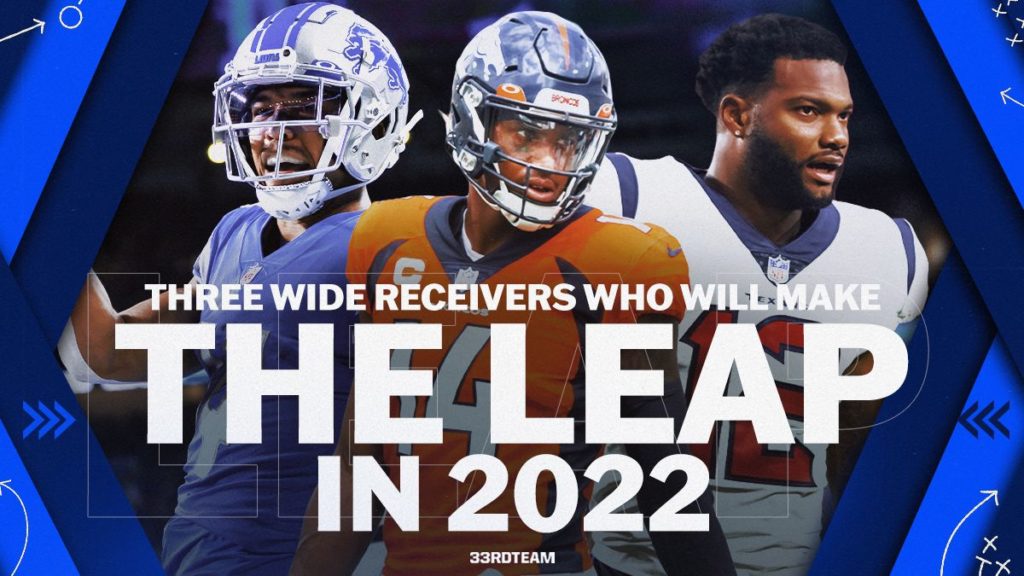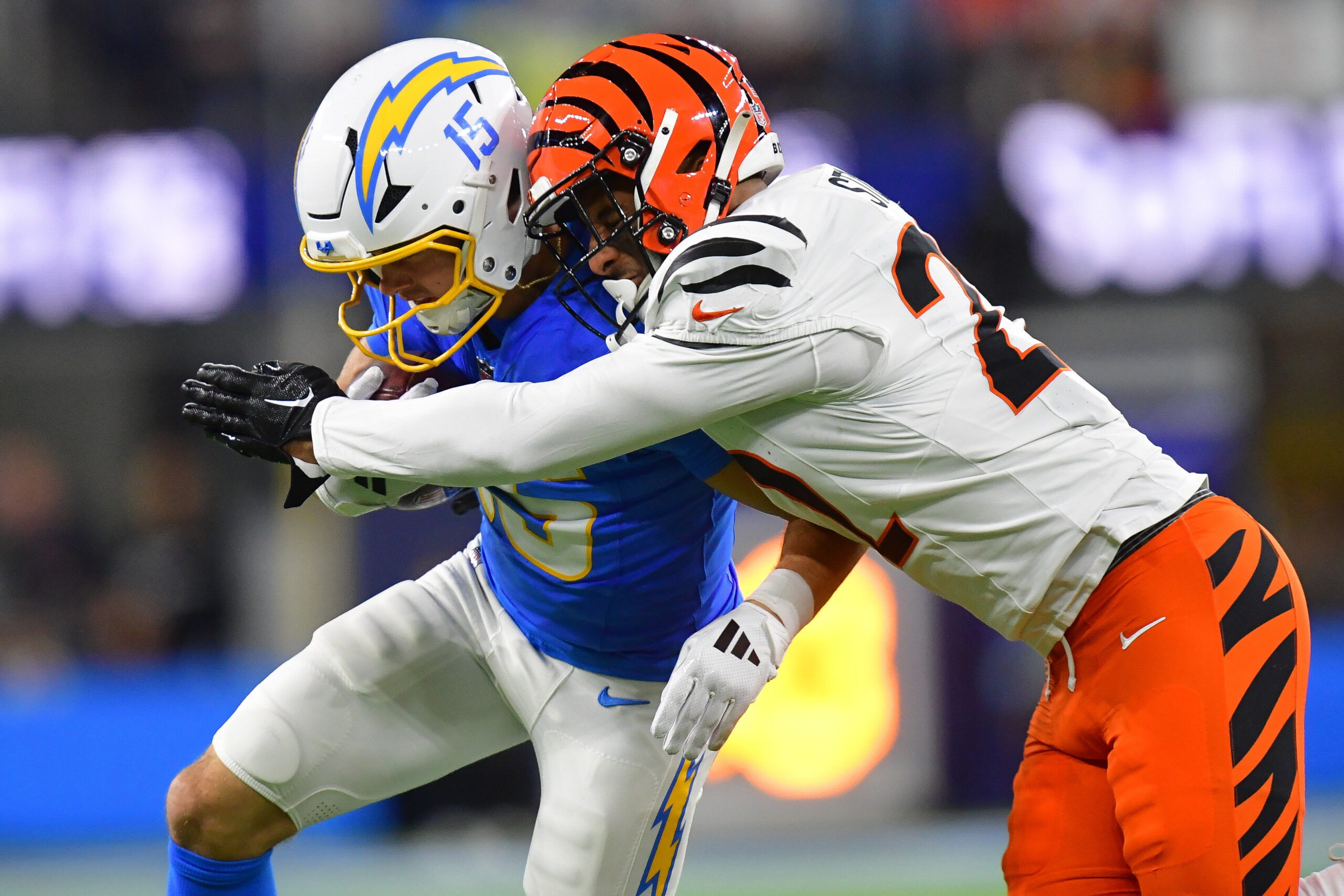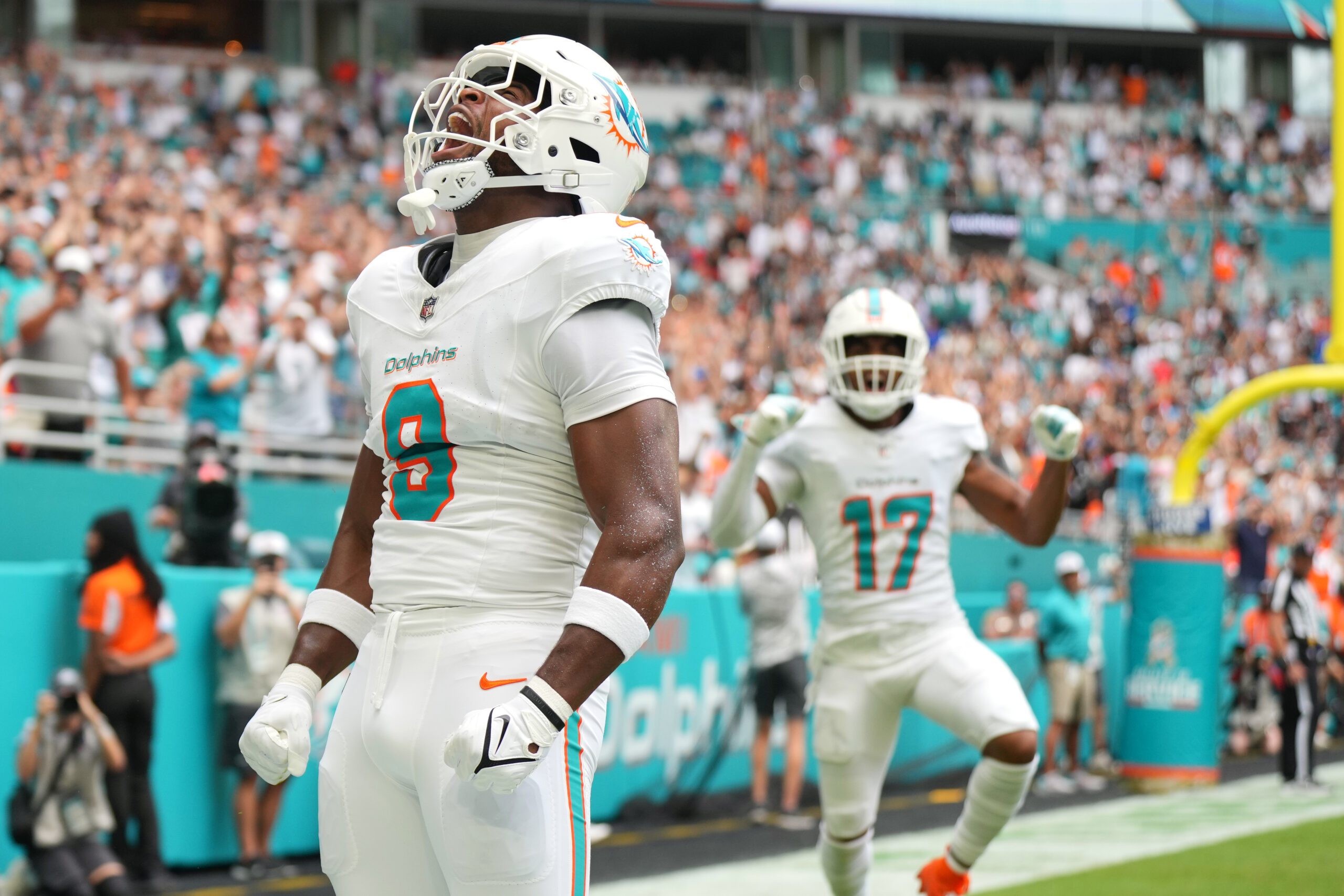Fantasy
8/12/22
10 min read
Three Wide Receivers Who Will Make the Leap in 2022

Average draft position (ADP) is often the result of a given player’s performance from the previous season. In some cases, a player’s most recent finish is just a developmental stepping stone on the path to a far higher ceiling. Identifying wide receivers candidates who are ready to make the leap into the next fantasy tier is a surefire manner of increasing your odds of winning a championship.
Amon-Ra St. Brown, Detroit Lions - Entering Year 2
Detroit Lions slot receiver Amon-Ra St. Brown is primed to take over as the Lions’ No. 1 receiver, and the fantasy community should continue drafting him aggressively at ADP across all scoring formats. St. Brown is currently being drafted at 6.01 on both Underdog and FFPC, 5.09 on ESPN, and 7.04 on Yahoo!.
St. Brown landed in the perfect place: on a team ran by former St. Louis and Los Angeles Rams Director of College Scouting, Brad Holmes. Holmes ascended through the then-St. Louis scouting ranks during the NFL’s slot receiver revolution of the early-2000s, a phenomenon in which the Rams played a league-leading role. Wide receivers like Kevin Curtis, Danny Amendola, Tavon Austin, and Cooper Kupp represent three of the various slot receiver archetypes that we still see today. Quarterback Jared Goff is the man who ties the room together, after years of carving up defenses with Kupp at his side.
In St. Brown, Holmes found a playmaker who bears a remarkably similar athletic profile to that of Kupp. St. Brown’s rookie-year usage was clearly similar to Kupp’s: out routes, hitches, crosses, and ins. Holmes added a wrinkle not seen often in Kupp’s game, though, sending St. Brown downfield on go routes 117 times in his rookie year. That total topped St. Brown’s chart as his most frequent route run. St. Brown also garnered a pre-snap slot alignment rate of 77%, 38% higher than what Kupp was afforded in the Rams’ Goff era, per TruMedia.com.
Running routes from the slot allows wide receivers to sometimes matchup against linebackers and safeties, which gives a route-running specialist like St. Brown a massive advantage. This combination of a high slot route rate, mixed with the diversity in St. Brown’s route depth, affords him the opportunity to receive quarterback-friendly short-area work, as well as high-variance, risk-it-for-the-biscuit deep balls. It’s a winning fantasy formula.
St. Brown’s impressive season-long per route averages were very impressive. On the year, his 1.74 yards per route run and his 22.8 targets per route run rate, ranked seventh and sixth best among all NFL rookies, respectively, per TruMedia.com. The Lions didn't give St. Brown a full-time role until Week 13, though. Filtering the data down to the season’s final 6 weeks, St. Brown’s yards per route run and targets per route run rates jump to 2.75 and 32.8%. Both figures ranked No. 1 among all first-year players.
While it is fair to point out that the team was missing do-it-all running back D’Andre Swift and pass-catching tight end T.J. Hockenson for much of that span, St. Brown still deserves credit for earning the team’s trust by responding thunderously to their call for help. During that span, St. Brown caught 51 of 67 targets for 560 yards and five touchdowns, with a two-point conversion on top. The team also dished him seven carries, which he took for a whopping 61 yards and one touchdown.
Fantasy drafters are understandably concerned about the addition of other wide receivers in first-round Jameson Williams and free agent field-stretcher D.J. Chark, but a profile as promising as St. Brown’s simply does not miss. He is the perfect player in the perfect system and has already proven that he is one of the league’s most capable slot receivers, even when the defense knows he is the primary read on Goff’s dropbacks. The sophomore receiver could comfortably surpass his WR21 finish in full-PPR scoring last year.
Courtland Sutton, Denver Broncos - Year 5
Courtland Sutton will be a fantasy football WR1 by year’s end.
The No. 40 overall pick in 2018, Sutton entered a tough situation. Then-Denver Broncos head coach Vance Joseph believed winning was achieved by establishing the run and playing stout defense, despite having a loaded pass-catching corps. Ownership tried to fix the offensive stagnation by jettisoning one old-school coach for another, Vic Fangio, and replaced journeyman signal-caller Case Keenum with a clown car of underwhelming passers: Joe Flacco, Drew Lock, and Brandon Allen. All three took snaps in 2019. In spite of it all, Sutton still compiled 114 receptions on 208 targets for 1,816 receiving yards, 10 touchdowns, and one trip to the Pro Bowl in his first two years.
Over the last two seasons, though, Sutton has continued to be dogged by bad coaching, poor quarterbacking, and an early-2020 ACL tear. Like many wide receivers before him, Sutton spent much of the following year regaining his footing post-ACL reconstruction. Sutton’s first year in the league produced moderate results on a per route basis, averaging 1.4 yards and a 17% target rate, per SportsInfoSolutions.com.
The Broncos must have liked what they saw from Sutton, though. They felt comfortable moving on from the late Demaryius Thomas and later sent Emmanuel Sanders to the San Francisco 49ers via trade, 7 games into the 2019 season. Sutton erupted in his sophomore campaign, averaging 2.2 yards per route run while and a 24% targets per route run rate.
With Green Bay’s former offensive coordinator, Nathaniel Hackett, now calling the shots and the NFL’s premier deep-ball passer in Russell Wilson at the helm, Sutton seems like a breakout star in the making.
Over the last three seasons, with Hackett operating as the offensive coordinator, Green Bay threw the ball on 55.6% of first-half early-downs. This routinely gave his quarterback opportunities to carve defenses packages that were geared towards stopping the run, per SharpFootballStats.com. That rate is 6.3% higher than Denver’s dreary 49.3% first-half early-down passing rate during that span. Since Wilson entered the NFL, he has completed 51 passes of 50 yards or more and 564 passes of 20-yards or more. Both totals rank third in the NFL.
During Sutton’s breakout 2019 campaign, the then-second-year receiver recorded 18 receptions of 20 yards or more and two receptions of 50 yards or more, catching passes from the aforementioned failure trio of Flacco, Lock, and Allen. The 20+ yard total tied for 16th in the league and the 50+ yard total tied for 11th. These two are a perfect match.
Hackett has also made clear that Wilson will dictate the offense’s tempo, and all signs point to Wilson preferring a near-breakneck pace. The more plays a team runs, the more opportunities the players have to produce. Denver made a habit of limiting offensive opportunities over the last three years, averaging just 60.2, which was the second-slowest pace during that span, so Hackett’s choice is a welcomed change.
Sutton’s potential target volume has drastically increased since the end of the 2021 season. Tight end Noah Fant was part of the package that acquired Wilson from Seattle and the recently paid wide receiver, Tim Patrick, sadly tore his ACL in late July. Downfield speedster K.J. Hamler is also returning from ACL reconstruction which, as mentioned above, can be a difficult hurdle to clear.
With Fant out of town and Patrick out for the year, Sutton now has two fewer proven, big-bodied targets to compete with. Jerry Jeudy, Albert Okwuegbunam, Greg Dulcich, and Hamler will all factor in, but none of them offer the same combination of size, speed, and jump-ball play-making ability as Sutton.
In Sutton, Wilson has as a downfield, difference-making 'X' receiver who should command the lion’s share of the targets in both two- and three-wide receiver sets. The fifth-year man is currently being drafted at 3.10 on Underdog, 6.02 on ESPN, 4.05 on FFPC, and 5.04 on Yahoo!. Expect Sutton to cruise past his 2019 PPR finish of WR19, which would make him a steal on all four platforms.
Nico Collins, Houston Texans - Year 2
Nico Collins entered the NFL as an extremely promising prospect, having led the University of Michigan in receiving as a 19-year-old sophomore in 2018.
Standing 6-foot-4, 215 pounds, Collins also tested very well at his 2021 Pro Day. Last year, the rookie wide receiver put together a decent rookie season, despite working in a lackluster offense and fighting through three separate injuries. Collins has all the opportunity in the world to take a big step forward in his second NFL season.
Houston made notable in-house promotions this year, hiring Lovie Smith as head coach and Pep Hamilton as offensive coordinator, and Smith quickly made clear that Hamilton will have full control of the Houston offense in 2022. Hamilton has built an impressive resume, mentoring some of the league’s best quarterbacks over the last 10 years.
His chosen West Coast scheme is famous for weaving together quick-hitting, lay-up targets for his wide receivers with heavy helpings of downfield play-action shots, which will help sophomore quarterback Davis Mills build on his strong rookie showing from last year. Per TruMedia.com, Collins’ most-run routes were the downfield go, hitch, and post, followed by the short-to-intermediate slant and cross. He fits perfectly in Hamilton’s system.
Houston affirmed their commitment to Collins as the team’s 'X' receiver of the future, adding only slot receiver John Metchie in the 2022 NFL Draft. Metchie’s career is tragically on pause while he battles a surprise diagnosis of Acute Promyelocytic Leukemia. Veteran downfield receiver Brandin Cooks will primarily operate as the field-stretching 'Z' receiver, which affords Collins ample opportunity to carve defenses up as a ball-hogging perimeter 'X' receiver.
Collins’ 1.24 yards per route run ranked 13th among all NFL rookies with at least 40 targets and his 16.6% targets per route run rate ranked 15th. These are not world-breaking numbers, but it is important to remember this was a largely dysfunctional offense that ran just 59.4 plays per game, which ranked 30th in the NFL. Collins also missed three games due to a shoulder injury early on, and he played hurt with foot and hip injuries as the year progressed. An increase in both total plays and pass attempts offers Collins an opportunity to significantly exceed the 60 targets that he saw in 2021.
Collins finished as just a fantasy WR8 in full-PPR scoring last year, so his path to even a mild leap won’t take much effort. His true ceiling, though, is far higher. During the final seven weeks of the season, when Collins was working as a full-time player, his yards per route run rose to 1.29, the eighth best in the rookie class (min. 20 targets), and his targets per route run rose to 18.9%, which was also good for eighth, per TruMedia.com.
Fantasy managers should expect Collins to take his game to the next level, now fully healthy entering 2022, and his current ADP is entirely palatable. The second-year man can be drafted at 13.08 on Underdog, 14.12 on FFPC, and is going undrafted on ESPN and Yahoo!. Armed with an ascending quarterback in an efficient system, Collins should be a strong candidate for a top-48 finish among wide receivers. Collins’ absolute ceiling outcome could take him even higher, should he be able to push Cooks for the Texans’ target lead.






